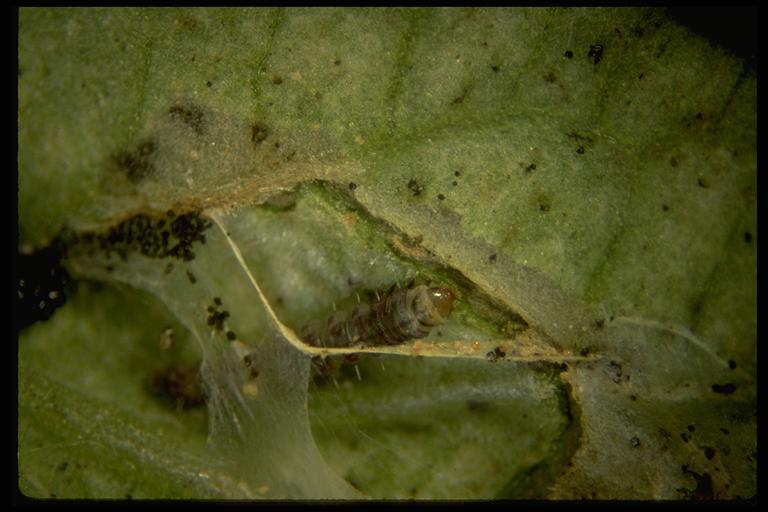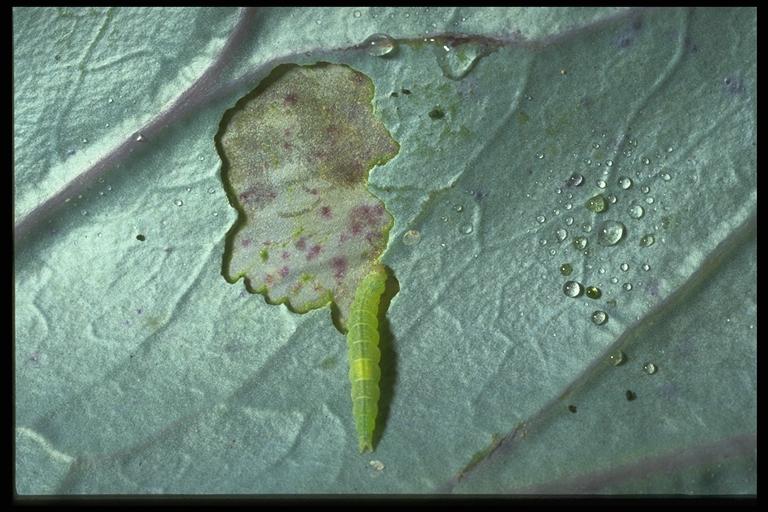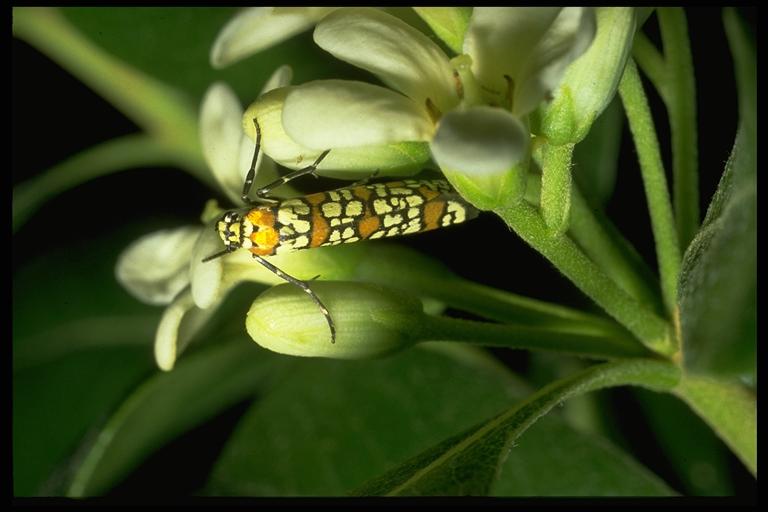
Tomato pinworm, Keiferia lycopersicella (Walsingham) (Lepidoptera: Gelechiidae), blotch-type mines and leaf-folding (left). Photo by Drees.
Common Name: Tomato pinworm
Scientific Name: Keiferia lycopersicella (Walsingham)
Order: Lepidoptera
Description: Caterpillars are small, 1/4 inch long when fully grown, and yellowish green to purplish black with brown head capsules.
Other common members of Gelechiidae include: the pink bollworm, Pectinophora gossypiella (Saunders); Angoumois grain moth, Sitotroga cerealella (Oliver); and the rednecked peanutworm, Stegasta bosqueella (Chambers). Closely related families include Plutellidae, which contains the diamondback moth, Plutella xylostella (Linnaeus), and the Yponomertidae, which contains the ermine moth, Attera punctella.
Life Cycle: The adult moth is small and brownish in color. Females lay eggs on the undersides of leaves in an erratic pattern on the upper half of the plant. Caterpillars hatch from the egg and grow incrementally through stages (instars) before pupating (into a chrysalis) in the soil. The life cycle is rather short, with 7 or more generations produced per year under greenhouse conditions within a 4 to 5 month period.

Diamondback moth, Plutella xylostella (Linnaeus) (Lepidoptera: Plutellidae), larva on cabbage. Photo by Drees.
Habitat and Food Source(s): Caterpillars have chewing mouthparts. Moths have siphoning mouthparts. Tomato pinworms are a major pest of greenhouse grown tomatoes, but will also infest field grown tomatoes, potatoes and eggplant. Small caterpillars produce serpentine and/or blotch mines in leaves, and later cause leaves to fold or roll at the midrib using tight silk webbing. Larger larvae chew pin-holes into the base, near the stem (under the calyx) of developing buds and ripening fruit. Caterpillars can be picked from infested plants. Adults can be reared from larvae or pupae, collected in pheromone traps or blacklight traps.
The pink bollworm, Pectinophora gossypiella (Saunders) (Lepidoptera: Gelechiidae) is a pest of cotton, primarily in west Texas. Adult moths have a wingspan of 2/5 inch and are grayish brown. Female moths lay greenish-white eggs singly, mainly on the stems, squares and bolls of cotton. Caterpillars grow to ½ inch and are whitish to pink with yellow-brown head capsules. Developing larvae bore into and feed on the developing flower or into a boll and feed on the seed. In bolls, larvae tunnel through the boll wall and cut through the lint fiber as they move from seed to seed, causing stained lint and seeds with reduced weight, vitality and oil content. Larvae feed for 10 to 14 days before cutting out of the boll to pupate in the soil. Development from egg to adult occurs in 25 to 35 days. Larvae and pupae of the overwintering generation remain in seed inside the boll.

Ermine moth or ailanthus webworm, Atteva punctella (Cramer) (Lepidoptera: Yponomeutidae). Photo by Drees.
Pest Status, Damage: Larval stages (caterpillars) damage leaves and fruit of field and greenhouse grown tomatoes; medically harmless.
For additional information, contact your local Texas A&M AgriLife Extension Service agent or search for other state Extension offices.
Literature: Little 1963. Metcalf et al. 1962; Westcott 1973.